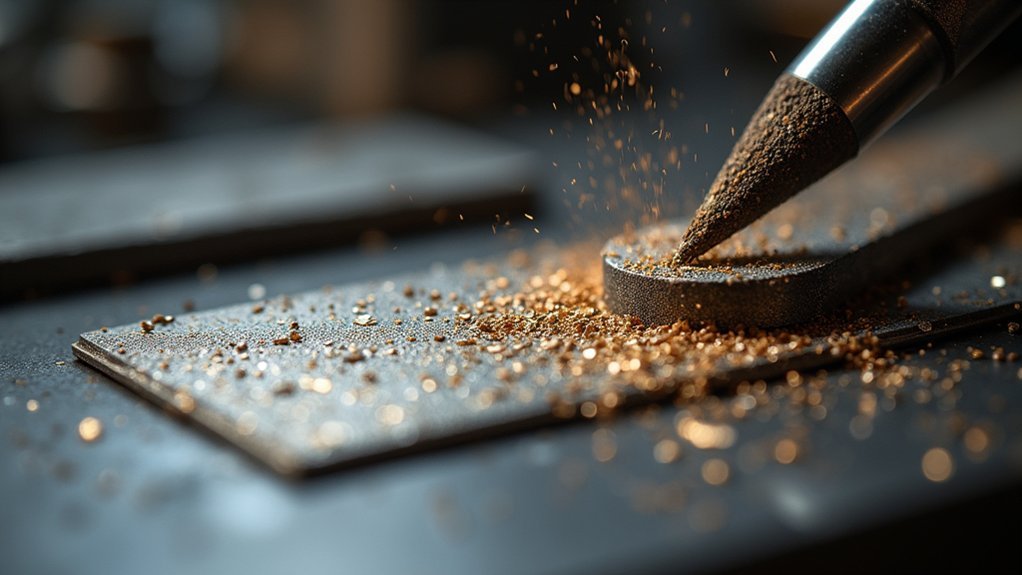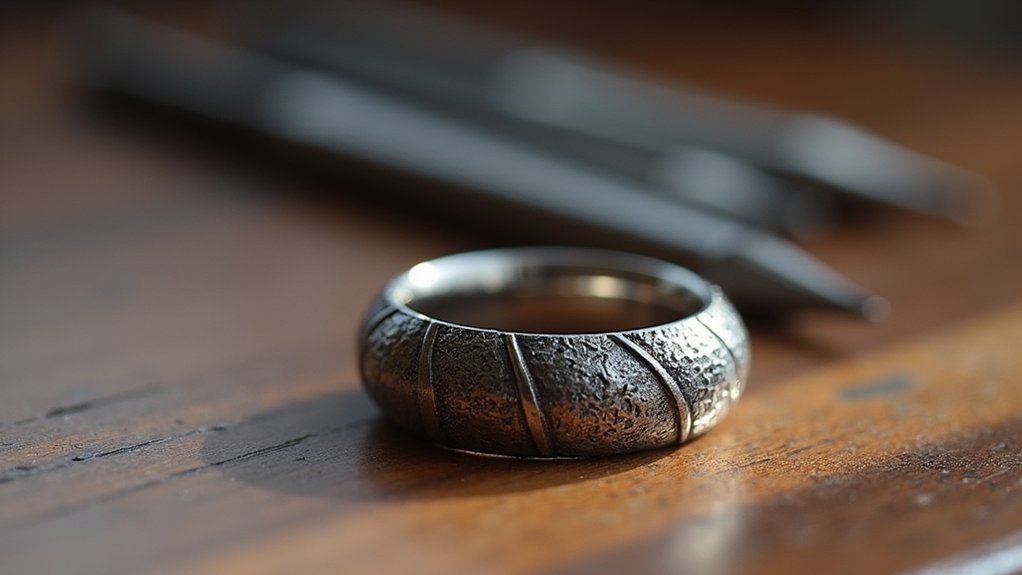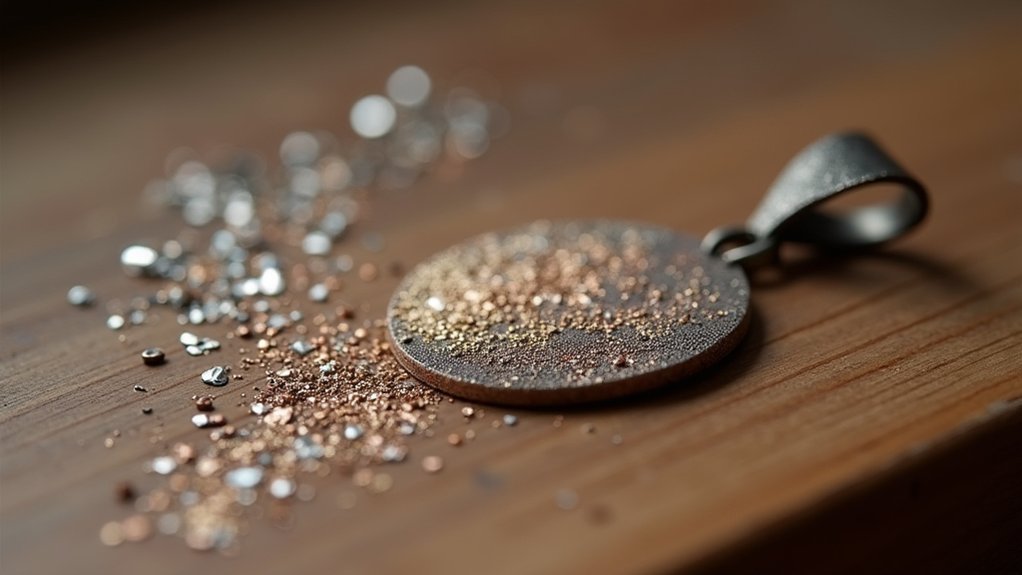Filing metal is essential in jewelry making as it transforms ordinary pieces into professional creations. You’ll achieve precise shaping, clean lines, and high-quality finishes that elevate your designs. Proper filing not only improves aesthetics but also strengthens your pieces structurally, reducing metal fatigue in high-stress areas. With the right tools and techniques, you can create intriguing textures and visual depth that catch light beautifully. The difference between amateur and professional-looking jewelry often lies in these finishing details.
The Impact of Proper Filing on Jewelry Design Quality

While many jewelers focus on the glamour of gemstone setting or soldering techniques, proper filing remains one of the most essential yet underappreciated skills in jewelry making.
When you master metal files, you’ll transform ordinary pieces into professional creations. Proper filing techniques enable precise shaping of your designs, creating clean lines that elevate the overall aesthetic.
Essential Filing Tools Every Jewelry Maker Should Own
Building a well-equipped jewelry workshop starts with selecting the right filing tools for your creative process. For beginners, a versatile cut 3 or 4 file handles multiple tasks while delivering smooth finishes on metal surfaces.
Your jewelry supply collection should include various types of files: flat, half-round, and needle files to address different metalwork challenges. Needle files, typically 16 cm long, are perfect for precision work in tight spaces and intricate designs.
When working on delicate pieces, consider barrette files with teeth on only one flat side, which help you avoid unwanted marks while shaping cut edges.
For lasting quality, invest in reputable brands like Friedrich Dick or Glardon Valtitan. These professional-grade tools will greatly enhance your half-round and detail filing work for years to come.
Advanced Filing Techniques for Professional Finishes

Once you’ve mastered basic filing skills, implementing advanced techniques will greatly elevate your jewelry’s professional appearance.
Consider using diamond files with adjustable hand vises for intricate metalwork, considerably reducing filing time while enhancing precision.
Diamond files paired with adjustable hand vises transform intricate metalwork, delivering superior precision while saving valuable bench time.
Experiment with different file cuts—#4 or #6 files excel for final finishing, ensuring smoother edges on your pieces.
Don’t underestimate ergonomic tools; proper grip techniques minimize fatigue during extended sessions, resulting in cleaner finishes.
Diversify your filing methods by incorporating straight filing and sculpting techniques to accommodate complex designs without sacrificing accuracy.
For truly professional finishes, explore alternative approaches like tumbling with stainless steel media or using silicone-based abrasive wheels.
These methods achieve high polish while reducing manual filing effort, helping you create jewelry that stands out for its impeccable craftsmanship.
How Filing Affects Metal Properties and Longevity
Beyond mastering techniques for professional finishes, understanding how filing impacts your jewelry at a structural level can dramatically extend its lifespan.
When you file metal properly, you’re not just creating aesthetic appeal—you’re strengthening the piece itself. Make sure you use the appropriate cut for different applications; finer files with smaller teeth on one side create burnished edges that resist wear and reduce metal fatigue.
This is particularly important for high-stress areas like a ring shank or stone setting. Your filing technique affects how metals respond to daily stresses—both small and large.
Creating Texture and Dimension Through Strategic Filing

While many jewelers focus primarily on filing for smoothness and precision, the true artistry emerges when you leverage strategic filing to create intriguing textures and visual depth.
One technique is to make distinctive patterns using half-round and barrette files, which works best when you’re looking to transform flat surfaces into dynamic focal points.
To set your designs apart, try using a file with a cut 3 or 4 to achieve varied textural effects that catch light beautifully.
File with a cut 3 or 4 creates distinctive textures that transform how light plays across your jewelry’s surface.
For intricate details, a set of needle files allows you to file away precisely in confined areas, creating texture that enhances visual interest.
You’ll find these techniques not only improve aesthetic appeal but also add comfort to wearable pieces by strategically shaping edges and creating dimensional elements that make your jewelry stand out.
Frequently Asked Questions
What Is the Purpose of a Metal File?
You’ll use a metal file to shape, smooth, and refine metal surfaces. It removes burrs, creates precise edges, and prepares pieces for finishing. It’s essential for achieving professional-looking results in your projects.
What Metals Should I Avoid in Jewelry?
For jewelry, you should avoid cheap plated metals, base metals like aluminum and tin, low-quality Indian/Pakistani metals, soft metals like lead and pewter, and nickel alloys which can cause skin reactions.
What Are Files Used for in Jewelry Making?
Files help you shape, smooth, and refine metal surfaces in your jewelry pieces. You’ll use them to create precise edges, remove excess material, and achieve clean finishes on your handcrafted designs.
Why Is It Not Advisable to Use Iron Metal in Making Jewelries?
You shouldn’t use iron for jewelry because it rusts when exposed to moisture, it’s heavy and uncomfortable to wear, lacks luster, can cause allergic reactions on skin, and isn’t as durable as precious metals.
In Summary
Filing isn’t just a basic step—it’s fundamental to your jewelry craftsmanship. You’ll find that mastering proper techniques elevates your designs from amateur to professional. With the right tools and skills, you’re able to create precise shapes, enchanting textures, and structural integrity that makes your pieces last. Whether you’re a beginner or seasoned artisan, your attention to filing directly impacts the quality and uniqueness of your jewelry.





Leave a Reply